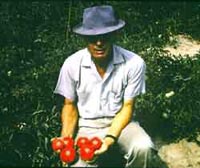Resource Library
Plant of the Week: 'Traveler' Tomato
The University of Arkansas System Division of Agriculture does not promote, support or recommend plants featured in "Plant of the Week." Please consult your local Extension office for plants suitable for your region.
Plant of the Week
'Traveler' Tomato
Latin: Lycopersicon esculentum

Tomatoes just aren't what they used to be. Sure they look great. While they may be blemish free and bright red, what happened to the taste I remember from a generation ago? As fewer Americans grow vegetable gardens, an entire generation of children has grown up unaware of what a homegrown, vine-ripened tomato can taste like.
For taste and quality, I prefer the Traveler tomato of a generation ago over the orbs now cluttering our grocery shelves.
Traveler tomato is a homegrown tomato released in 1971 by Joe McFerran of the University of Arkansas Horticulture Department. It has a distinctive pinkish look due to the absence of a yellow pigment in the epidermis, a characteristic perpetuated during the breeding process to distinguish it as a high quality product. McFerran developed the cultivar for the tomato growers of southeastern Arkansas, but it's equally at home in the home garden.
McFerran, who retired from the university in 1986, grew up during the Depression on a farm near Charleston in Sebastian County. In 1954, he began working with the state's tomato industry.
McFerran tells me that in post-war Arkansas, every little community in the Ozarks had a tomato cannery that processed locally produced tomatoes. Each cannery had a complete set of brand labels and would slap on whatever label the customer wanted when the cans were sold.
Prices for growers were only $10 per ton for fresh fruit and yields were low, so the 100 or so small canneries began closing as larger firms such as Siloam Spring's Allen Canning Co. grew. The small canneries were all gone by 1970.
During the 1950s, a fresh market industry developed in the piney woods of southeastern Arkansas around Warren in Bradley County. Farmers were growing a Louisiana cultivar, Gulf State Market, and hauling their vine ripened fruit to Little Rock for sale. But this tomato had problems. During wet periods when the humidity was high, cracks developed in the fruit that seriously reduced the quality. Also, the variety was susceptible to fusarium wilt, a serious soilborne disease of tomatoes.
McFerran crossed Gulf State Shipper with a USDA-numbered line resistant to fusarium wilt and produced a wilt resistant selection called Bradley, which he released in 1961. Bradley, still grown by Warren area tomato growers for their household use, was a high quality eating tomato, but it still was prone to crack when it rained too much or the humidity got high.
During the 1960's, McFerran developed a test for selecting tomatoes that showed improved crack resistance. Out of this work, Traveler was released in 1971.
The southeastern tomato industry has consistently generated sales of $8 to $12 million dollars, but it has not been immune to the changes wrought by economic conditions. From its beginning until the mid 1980s, the industry was primarily based on small growers who produced 5 to 8 acres of fruit, primarily using family labor for growing and packing the fruit.
The distinctive pink-fleshed Traveler tomato was a marketing advantage while the retail marketplace was dominated by mom-and-pop stores. But as supermarket chains began to dominate after the mid 1970s, buyers wanted everything to look the same. To them, tomatoes should be red. By 1990, the southeastern Arkansas industry began shifting to the red-fleshed "Mountain" series of cultivars developed in North Carolina. Tomato growers now often have 20 acres or more of production and rely heavily on migrant labor to assist in the harvest.
No sinister plot was hatched in the corporate boardrooms of America to deprive the American public of a quality tomato. The tomato has fallen victim to our mass-market economy that focuses on production, distribution and eye appeal. To satisfy these demands, growers have been forced into choices that work counter to eating quality. The juices and thin skin that make a tomato good for eating run counter to the characteristics that make it a good shipping tomato.
Traveler and Traveler 76 tomatoes are still around but it may take a treasure hunt to find them. Some of the independent garden centers still grow Traveler transplants in the spring, hoarding their remaining seeds like the rare gems they are.
By: Gerald Klingaman, retired
Extension Horticulturist - Ornamentals
Extension News - June 28, 2002
The University of Arkansas System Division of Agriculture does not maintain lists of retail outlets where these plants can be purchased. Please check your local nursery or other retail outlets to ask about the availability of these plants for your growing area.